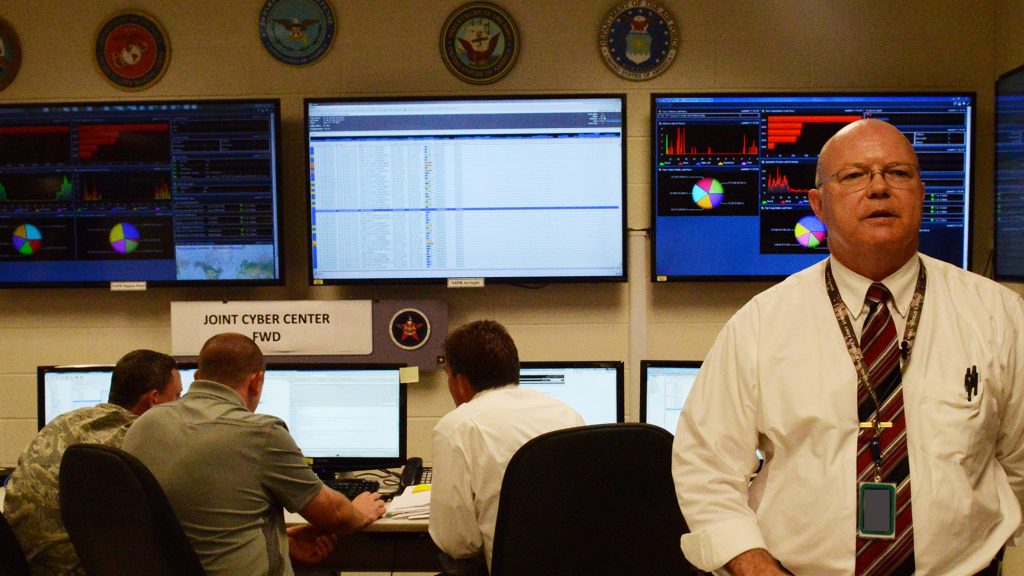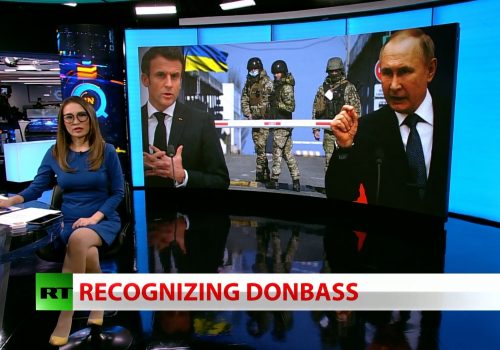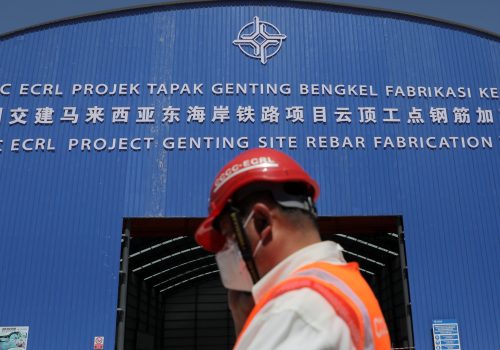The 2022 National Defense Strategy (NDS) marks a change in the Pentagon’s tone in several ways, but the most distinctive change may be the emphasis on operating in the gray zone—which was entirely absent from the 2018 summary. With the publication of the 2022 strategy, the Department of Defense (DOD) is officially recognizing that the escalation of competitors’ coercive and malign activities in the gray zone present a challenge to US security; it also calls for campaigning across all spectrums of conflict, pushing the department to make a deliberate effort to coordinate its activities and investments across various theaters and domains. Our experts from the Gray Zone Task Force within the Scowcroft Center for Strategy and Security’s Forward Defense practice, which aims to develop an integrated strategic framework for US operations in the gray zone, map out what this new focus means for the US defense industry in the coming years.
1. What exactly does the Pentagon mean by activities in the gray zone?
The NDS defines gray zone methods as “coercive approaches that may fall below perceived thresholds for US military action and across areas of responsibility of different parts of the US government.” That definition acknowledges that strategic competitors are increasingly taking the fight off the physical battlefield and using unconventional and nonmilitary means to undermine US and allied security. Adversaries such as China and Russia are not solely—or even primarily—targeting military assets, but rather they are fueling societal and cultural fissures, shaping the information domain, and disrupting economic markets and trade. This is not a new concept: China’s and Russia’s use of nonmilitary means of warfare dates back to Operation Desert Storm, wherein the United States walked away celebrating a decisive battlefield victory while US adversaries began visualizing a future fight in which they could compensate for unparalleled US conventional power through hybrid means.
The DOD’s definition of gray zone activities can be interpreted as purposefully broad, implying that a discussion of modern warfare today is incomplete without discussing threats permeating from the gray zone. However, it is notable that the NDS opted to characterize only competitor or adversary methods as falling within the gray zone, even while mentioning comparable US and allied capabilities and approaches.
Overall, this NDS’s definition of gray zone methods broadens the US defense community’s understanding of who is being targeted in the gray zone and thus who should be implicated in the DOD’s response—and more significant than the definition itself is the prioritization placed on the gray zone. However, this is only one step in the right direction, as different US agencies and departments are currently working under different understandings of what does and does not fall within the gray zone. This lack of consensus or coordination, coupled with an overall lack of direction as to whether and how the United States should fight in the gray zone, hinders an effective whole-of-nation response to a whole-of-nation problem.
—Julia Siegel is an assistant director with the Scowcroft Center’s Forward Defense practice.
2. How do gray zone activities fit into the DOD’s integrated deterrence concept?
Integrated deterrence is, at its heart, about shaping behavior to “convince potential adversaries that the costs of their hostile activities far outweigh any possible benefits,” as Defense Secretary Lloyd Austin explained. Integrated deterrence ultimately relies on a full spectrum of incentives, disincentives, messaging, and negotiation, underwritten by credible deterrents of conventional and/or strategic military action. Unsurprisingly, a good amount of the spectrum below the threshold of active armed conflict will reside in the gray zone.
The United States must react to adversarial activity in the gray zone, especially in areas that adversaries perceive as important, to reduce their efficacy; that will require responses that are appropriate, proportionate, and effective. Equally important, the United States must engage proactively in the gray zone to shape competitors’ behavior. Some of the capabilities needed for engaging in the gray zone exist within the DOD, with many housed within US Special Operations Forces core activities, as well as theater security cooperation activities and those at a national level that transcend a single geographic combatant command such as coordination with Five Eyes partners (Australia, Canada, New Zealand, and the United Kingdom) across the globe. Other capabilities, while not organic to the department, are at its disposal through effective partnerships with the intelligence community, other departments (e.g. State, Treasury, and Commerce), and alliances and partnerships. Improving the way the DOD leverages partnerships can potentially result in better outcomes than replicating the partners’ capabilities.
A critical part of integrated deterrence will be how the United States articulates its so-called “red lines,” or adversarial actions that trigger a US military response. In order to effectively shape behavior that supports US and allied interests, US strategy and execution must erase any doubt that such limits and consequences do exist, while simultaneously reducing adversary confidence about their knowledge of precisely where those red lines lie. That deliberate ambiguity keeps adversaries from thinking that everything up to the red line would be “fair game,” and avoids inviting lower-level malign activity. It also avoids the optics of a United States’ “bluff” being called, in part, to avoid walking back on pronounced lines. Lastly, engaging in the gray zone will buy the maneuver time and space required to maintain its competitive edge and deter aggression in the future—the United States cannot waste this advantage with denial, handwringing, and partisanship—especially when it comes to China.
—Arun Iyer is a nonresident senior fellow with the Scowcroft Center’s Forward Defense practice and leads its project Adding Color to the Gray Zone.
3. The NDS differentiates between China as the pacing threat and Russia as an acute threat. What does that look like in the gray zone?
The NDS correctly notes that China and Russia pose unique challenges to the United States. The two countries differ in how they impact the United States and in how long their threats last. China’s advances in technology, access to third-country governments and resources, and role as a key global manufacturer means that the United States and allied countries face a strategic, long-term competition against China. All-out war against China would devastate the global economy and cripple US-owned multinational businesses. In contrast, Russia lacks the reach of its Soviet Union days and its impacts on global markets are mostly limited to petrochemicals. As highlighted in its efforts in Ukraine, the Russian military’s decline has been noticed in the waning professionalism of its forces, reliability of material, and overall investment and research and development. Russia would struggle to project traditional military power much outside its border areas.
China, despite recent economic troubles, is a nation on the rise and one that feels it deserves a place at the top of the world order. Although its population is forecasted to decline in the coming years, China will be a global force for decades to come—and its network of businesses, investments, and expatriates provide the country unique access to capabilities that it can leverage both in the gray zone and to meet traditional military goals. For example, TikTok may offer China the ability to push specific anti-US government content to users of the app in North America or in locations where there are ongoing US or NATO military operations. China’s continued investment in technology, education, and international relationships means that the country will continue to build this access in business, academia, and local politics in countries around the world—levers that can be pulled to meet China’s goals without the use of traditional military operations.
In contrast, Russia’s gray-zone capabilities are limited outside of its use of the paramilitary Wagner Group, information manipulation in the digital space, and traditional diplomatic efforts which include foreign intelligence operations to project power and contribute to paramilitary, influence, and harassment operations. As the political elite focuses on ways to make the domestic Russian audience feel powerful during a period of population and economic decline, gray-zone efforts will likely focus on meeting specific needs such as port access or supporting international political leaders. The Kremlin will aim to look strong to domestic and regional audiences, especially in Eastern Europe and South Asia, where Russia typically has influence. Moscow’s overarching threat to global interests will be its use of information operations to sow discord, clearing entry ways for Russian intelligence and business leaders to access locations of interest and providing localized support to fighting parties where political interests align.
—Jennifer A. Counter is a nonresident senior fellow within the Scowcroft Center’s Forward Defense practice and is a member of its Adding Color to the Gray Zone Task Force.
4. Deterrence is inherently a messaging game. What does this NDS say about the DOD’s approach to information operations?
Deterrence depends on the adversary’s perception of the United States’ capabilities and intent to use them. It also depends on an impression that if the adversary were to present a challenge, the United States would be able to cause enough damage to outweigh any gain for the adversary and its interests. Gauging an adversary’s perception, therefore, is necessary to understand the current deterrent threshold. Moving the threshold, if necessary, is dictated by how well a military manages the information domain. If a deterrent threshold is evaporating or degrading over time, then adjustments must be made to capabilities and perceived intentions, and then adequately conveyed to the adversary to restore the value of the deterrent. The NDS highlights the Pentagon’s aim to enhance its ability to operate in the information domain as a necessary component of this strategy.
Yet questions remain. The NDS highlights several new features with significant information elements to help organize and subsequently execute military activities across the entire conflict spectrum. First, the NDS’s focus on integrated deterrence calls for improvements across domains, agencies, and countries to better manage conflict in the information domain. Second, campaigns that cover the entire conflict spectrum—overlayed with the increased demands of implementing integrated deterrence—will require significant additional resources for all information components of the DOD. Who will manage a global information campaign in which all departmental information resources must be coherent, synchronized, and operationally relevant? Will the president’s budget for fiscal year 2024 reflect the need for additional resources to adequately coordinate campaigns that are overlapping and will run simultaneously across agencies, partners, and allies? Finally, is the department adequately organized to elevate information operations as a preeminent component of national power needed to implement integrated deterrence? The NDS is a good step forward, but organization and resourcing leading up to fiscal year 2024 will determine whether it can be implemented.
—Robert J. Giesler is a nonresident senior fellow with the Scowcroft Center’s Forward Defense practice and is a member of its Adding Color to the Gray Zone Task Force.
5. How can the US government and private sector complement traditional military efforts?
In roughly eighty pages, the 2022 NDS references economic tools fewer than a dozen times. While not surprising given that the document sets forth the DOD’s strategy, which consists primarily of non-economic tools, this underscores the importance of relying on other government agencies and departments to address what the NDS refers to as “economic coercion” carried out by the China against the United States and its allies and partners. China’s Belt and Road Initiative is the shining example of this coercion, as it forces recipient nations to forfeit direct or indirect control over key strategic assets (such as a ports, airports, rail lines, and highways) if they fail to pay commercial loans. However, myriad other examples of economic coercion exist, including currency manipulation, technology transfer requirements (i.e., China requiring foreign firms to transfer technology to local firms in exchange for market access), and punitive tariffs.
So how can the United States combat economic hybrid warfare? The NDS acknowledges that DOD ought to rely on other agencies to take the lead on economic matters in the gray zone, stating that in many cases, tools such as economic measures “conducted by other US departments and agencies may prove more effective” than DOD’s military tools. This is where the panoply of US trade agencies—in conjunction with the Treasury and Commerce departments—can play a key role by establishing consistent, cross-agency policies regarding foreign investment, credit finance, trade policy, and sanctions to protect US defense interests and regain economic advantage. Still, DOD plays a significant role in advising these agencies on how to prioritize geographic focus areas and in evaluating where the greatest economic threats to US national security exist.
—David Fogel is a nonresident senior fellow with the Scowcroft Center’s Forward Defense practice and is a member of its Adding Color to the Gray Zone Task Force.
6. How should the DOD change its approach to counterintelligence (CI) under the integrated deterrence framework?
Integrated deterrence ought to include the use of CI capabilities resident within DOD’s authorities via Title 10 of the US Code, which outlines the DOD’s role in conducting military activities; Title 50 of the US Code, which grants the DOD and the intelligence community the authority to conduct intelligence and CI activities; and Executive Order 12333, which initially laid out the DOD’s intelligence and CI responsibilities. As the NDS notes, the United States can strengthen deterrence by conducting actions that raise an adversary’s cost with respect to the “perceived benefits of aggression.” One of the ways this can be accomplished is through synchronized messaging, complemented by real-world open activities and actions that utilize offensive CI operations in concert with the DOD planning community. For example, the DOD might use CI assets to pass information about a policy intent that complements a stated White House or State Department decision, all while moving DOD personnel and material into the theater to reinforce the United States’ overall intent.
Similarly, leveraging CI capabilities can help improve the resiliency of the vital networks and critical infrastructure supporting the cyber and space domains, as they utilize the same personnel, equipment, networks, and supply chains feeding into CI. The first order of business should be securing US supply chains in line with the Pentagon’s vision of delivering uncompromised, which is a DOD program aiming to bolster security across the entire defense enterprise by ensuring that foreign intelligence entities haven’t compromised technology (for example with insider threats or compromised chips) in the manufacturing process, which would assist with building enduring advantages throughout the defense ecosystem. To do so, the United States must move the manufacture of critical components back onshore to the United States and then use the tools and tradecraft of CI to ensure that the personnel, networks, intellectual property, and manufacturing processes associated with these “can’t lose” technologies are both vetted and protected.
—Thomas Ferguson was a member of Forward Defense’s Adding Color to the Gray Zone Task Force before assuming a position in government.
7. How can the Pentagon better leverage domestic and international partners, and the capabilities they own across domains, to fortify its integrated deterrence?
The NDS mandate to leverage every capability and advantage at DOD’s disposal, particularly to use advantages that DOD does not organically own, is astute and could not come at a better time for the United States. The two-decade war on terror provides a strong precedent for cross-government cooperation, which is potentially still applicable even as the US government shifts its focus from counterterrorism to strategic competition with China and Russia.
As a former Central Intelligence Agency leader, I saw first-hand the development, implementation, and impact of what was nicknamed “Title 60”—the portmanteau of titles 10 and 50 of US code—wherein the DOD and intelligence community (IC) worked seamlessly on the counterterrorism mission. This integrated cooperation between exquisite capabilities is the textbook example of what the NDS calls for, particularly in addressing competition in the gray zone. For example, both the IC and Special Operations Forces worked together to become experts at man-hunting in the war on terror, fusing signals intelligence, human intelligence, and overhead capabilities to ensure few places globally were out of reach in conducting “find, fix, finish” missions against terrorist targets. Such capabilities can similarly be used against today’s strategic competitors—why not merge joint talents to find hostile foreign intelligence officers working against US interests across the globe?
In sum, successes in the US war on terror were critically dependent on bilateral and multilateral partnerships. Both the IC and DOD deeply understand the value of partners, justifying integration on many levels such as intelligence sharing and (at times) cross-training. To meet the NDS remit to address gray zone threats, the DOD must build on these relationships and lessons and not let a new issue set cause formerly integrated capabilities to atrophy.
—Marc Polymeropoulos is a nonresident senior fellow with the Scowcroft Center’s Forward Defense practice and is a member of its Adding Color to the Gray Zone Task Force.
Further reading
Fri, Sep 30, 2022
How the US can focus its fight against foreign influence operations
Hybrid Conflict Project By Jennifer A. Counter
Understanding exactly what US adversaries plan to do in the information space is vital to building domestic defenses.
Fri, Jun 10, 2022
The future of US security depends on owning the ‘gray zone.’ Biden must get it right.
Hybrid Conflict Project By Clementine G. Starling-Daniels, Julia Siegel
The United States' ability to prevail in the gray zone will hinge on coordinating and executing a whole-of-nation response.
Mon, Apr 25, 2022
I helped defend against China’s economic hybrid war. Here’s how the US can respond.
New Atlanticist By
Washington must regain its strategic momentum relative to China and stem Beijing's global economic influence.
Image: Cyber defense operations using ArcSight at the US Army Communications-Electronics Command, Aberdeen Proving Ground, Maryland, on June 25, 2014. Picture taken June 25, 2014. Photo via David Vergun/US Army.



